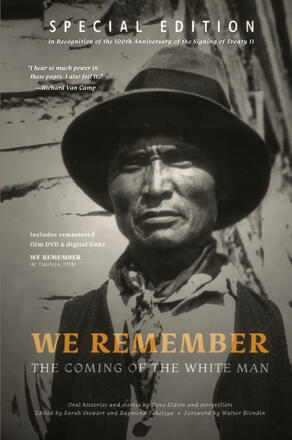
We Remember the Coming of the White Man
Special Edition in Recognition of the 100th Anniversary of the Signing of Treaty 11
La description
SPECIAL 2021 EDITION, recognizing the 100th Anniversary of Signing of Treaty 11. We Remember the Coming of the White Man chronicles the history of the Sahtú (Mountain Dene) and Gwinch’in People in the extraordinary time of the early 20th century. This 2021 Special Edition of the book recognizes the anniversary of the signing of Treaty 11, which is greatly controversial due to the emotional and economic fallout for the People. As well as poignant essays about Treaty 11, the book includes transcripts of oral histories by Elders. They talk about the early days of fur trading and guns; the flu pandemic; and dismay about the way oil and uranium discoveries and pipelines were handled on their land. A new section of stories is included as well — stories by Leanne Goose, Antoine Mountain, Raymond Yakeleya, and George Blondin. The remastered film “We Remember,” is included with the book, on DVD and as digital Vimeo links. https://durvile.com/books/We_Remember_Special.html
Reviews
“Our traditional knowledge is recorded in the stories of our ancestors since time immemorial. In this book, you will read our oral history and traditions that are our Dene parables, used to guide ourselves and our People.”
—Dene National Chief Norman Yakeleya
We Remember The Coming of the White Man should be crucial reading for anyone in Canada because it speaks to the resiliency of the Dene and Metis people of Denendeh. It's also a testament to the power of memory carried in the oral tradition. To think what our ancestors have seen in one lifetime: relations with the Hudon's Bay Company,TB, Influenza, Treaty signings, the first musket loader, Residential Schools, the first radio, the first TV, a man on the moon. It is staggering. I hear so much power in these pages. I also feel it. I am grateful to everyone involved in this project because it is a life's work honouring the witnessing of so much change in so little time. Mahsi cho, everyone. I am grateful. We will have and celebrate this book and the DVD that accompanies it forever.
— Richard Van Camp
With rare mastery of his filmmaking craft, Dene storyteller Raymond Yakeleya carries on in this book, bringing a former and still ever-present world of wolf, bear, and raven, ik’o, medicine, magic, and mystery to life, to modern meaning.
—Antoine Mountain, author of From Bear Rock Mountain: The Life and Times of a Dene Residential School Survivor